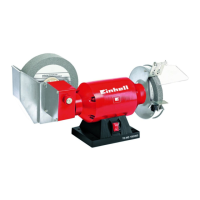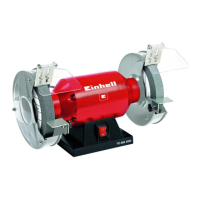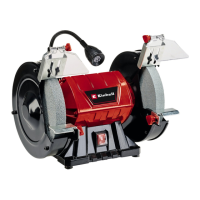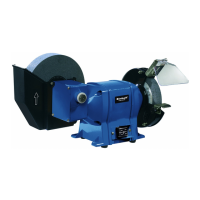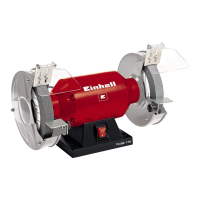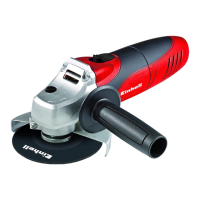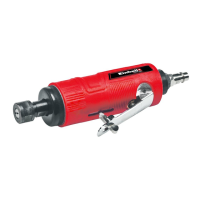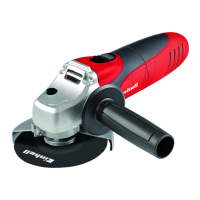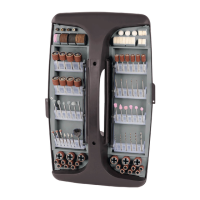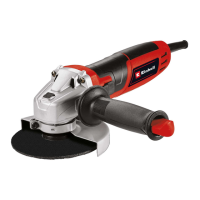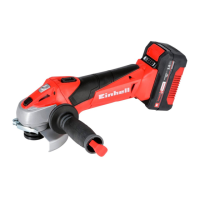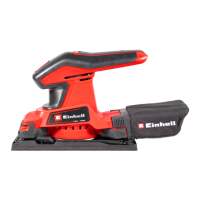GB
- 22 -
6.3 Wet grinding (Fig. 9)
•
Before starting work, check that the wet grin-
ding wheel (5) is deep enough in the water
(see 5.1).
•
Set your sharpening angle on the angle
gauge (17) (see 5.3).
•
Fasten the tool you wish to work on in the
clamping device (2) (see 5.4).
•
Set your sharpening angle on the machine
(see 5.4).
•
Turn on the grinding machine using the ON/
OFF switch (1).
•
Grip the clamping device (2) with both hands.
Slowly lower the tool onto the wet grinding
wheel (5).
•
To achieve a blade which is as sharp as
possible, only press the tool lightly onto the
wet grinding wheel (5). As a general rule, the
following applies: the less the pressure, the
sharper the result. The more the pressure that
you apply, the greater the amount of material
you will remove.
•
Move the tool slightly back and forth to pro-
duce an optimal grinding result. This way the
grinding wheel (5) will also be evenly worn.
Caution!
If the grinding wheel becomes jammed during
operation, remove the workpiece and wait until
the equipment reaches its top speed again. You
may have to guide the workpiece towards the
grinding wheel with less force.
6.4 Preparing the honing wheel (Fig. 10)
•
Before you can use the honing wheel (6), you
have to prepare it with the honing compound
(16) first.
•
Apply a little honing compound (16) to the ho-
ning wheel (6) and spread it evenly. You can
use a cloth or sponge, for example, to do this.
•
Caution! Never use the honing wheel (6)
in a dry state. The honing compound (16)
prevents the surface of the honing wheel (6)
drying out and becoming porous.
•
Important! Apply the honing compound (16)
regularly to prevent the honing wheel (6) dry-
ing out.
6.5 Honing (Fig. 11/12)
•
For a sharper blade you can hone the tool
blade after wet grinding (see 6.3).
•
Warning! Never position the tool blade
against the direction of rotation of the honing
wheel. The tool would cut into the surface of
the honing wheel!
•
Turn on the grinding machine using the ON/
OFF switch (1).
•
Grip the tool with both hands and lower it
slowly onto the honing wheel (6).
•
To make the blade as sharp as possible, draw
both the front and back of the blade edge
over the honing wheel (6).
•
Move the tool slightly back and forth to produ-
ce an optimal result.
•
Important! If the honing wheel (6) becomes
blocked while you are working even though
you only apply light pressure, you can increa-
se the contact pressure of the drive shaft (29)
using the adjustment screw (30) (see Fig. 12).
7. Replacing the power cable
Danger!
If the power cable for this equipment is damaged,
it must be replaced by the manufacturer or its
after-sales service or similarly trained personnel
to avoid danger.
8. Cleaning, maintenance and
ordering of spare parts
Danger!
Always pull out the mains power plug before star-
ting any cleaning work.
8.1 Cleaning
•
Keep all safety devices, air vents and the
motor housing free of dirt and dust as far as
possible. Wipe the equipment with a clean
cloth or blow it with compressed air at low
pressure.
•
We recommend that you clean the device
immediately each time you have finished
using it.
•
Clean the equipment regularly with a moist
cloth and some soft soap. Do not use
cleaning agents or solvents; these could at-
tack the plastic parts of the equipment. Ensu-
re that no water can seep into the device. The
ingress of water into an electric tool increases
the risk of an electric shock.
•
Empty, rinse and fill the water container (10)
regularly with clean water. Sediment can
collect on the wheel and reduce the level of
grinding performance.
Anl_TC-WG_200_SPK9.indb 22 07.09.2020 14:38:52
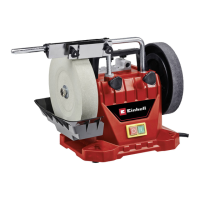
